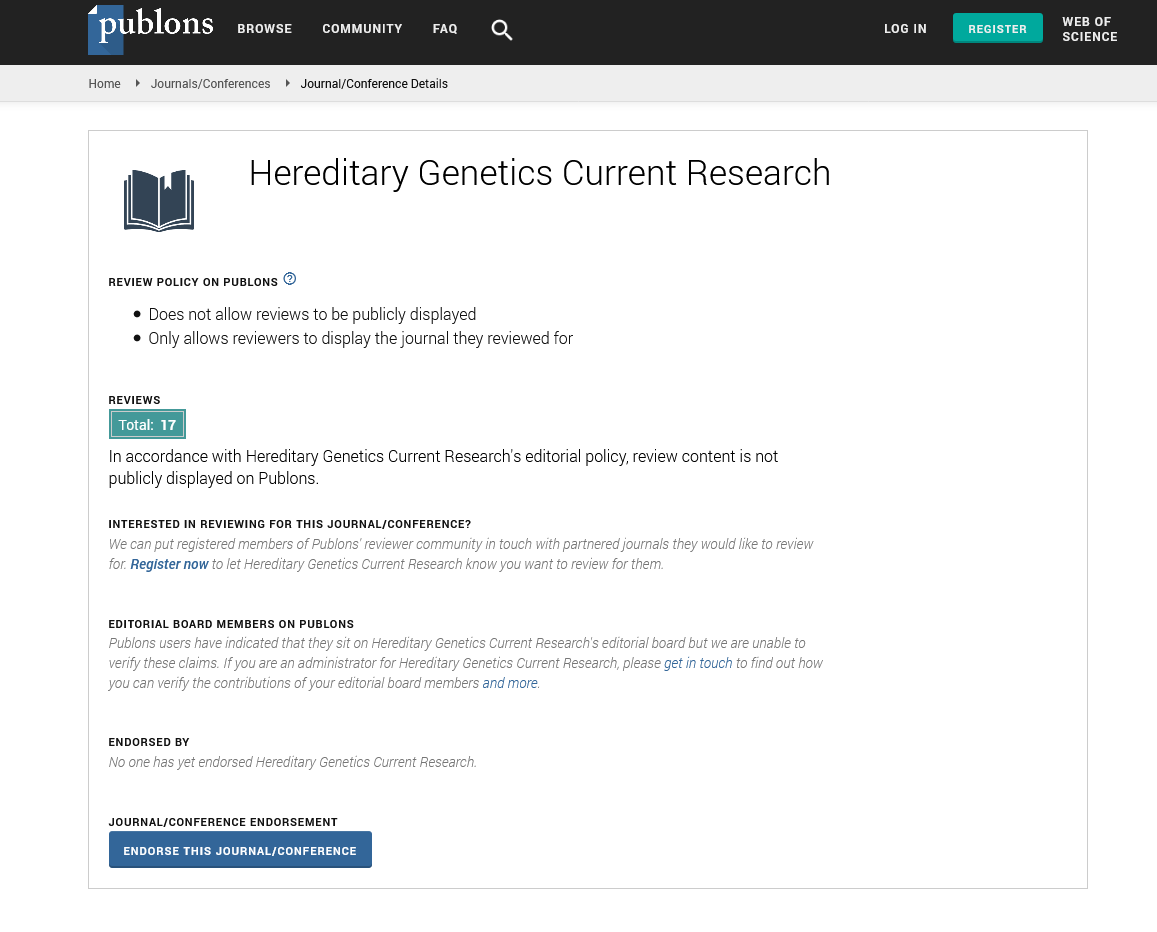Indexed In
- Open J Gate
- Genamics JournalSeek
- CiteFactor
- RefSeek
- Hamdard University
- EBSCO A-Z
- NSD - Norwegian Centre for Research Data
- OCLC- WorldCat
- Publons
- Geneva Foundation for Medical Education and Research
- Euro Pub
- Google Scholar
Useful Links
Share This Page
Journal Flyer

Open Access Journals
- Agri and Aquaculture
- Biochemistry
- Bioinformatics & Systems Biology
- Business & Management
- Chemistry
- Clinical Sciences
- Engineering
- Food & Nutrition
- General Science
- Genetics & Molecular Biology
- Immunology & Microbiology
- Medical Sciences
- Neuroscience & Psychology
- Nursing & Health Care
- Pharmaceutical Sciences
Opinion Article - (2025) Volume 14, Issue 1
Role of Genotypic Analysis in Clinical Research: Key Components of Phase I-IV Clinical Trials
Laura Doe*Received: 26-Feb-2025, Manuscript No. HGCR-25-28186; Editor assigned: 28-Feb-2025, Pre QC No. HGCR-25-28186 (PQ); Reviewed: 14-Mar-2025, QC No. HGCR-25-28186; Revised: 21-Mar-2025, Manuscript No. HGCR-25-28186 (R); Published: 28-Mar-2025, DOI: 10.35248/2161-1041.25.14.302
Description
Genotypic analysis and the progression through Phase I-IV clinical trials are foundational to advancing medical science and improving therapeutic outcomes. Genotypic analysis, as a tool for understanding genetic variations, offers profound insights into the mechanisms of diseases and their potential treatments. The clinical trial process ensures that these treatments are safe and effective, bridging the gap between genetic research and clinical application. Genotypic analysis refers to the examination of an organism's genetic makeup to identify variations in DNA sequences. This analysis plays a crucial role in identifying genetic predispositions to diseases and understanding the molecular basis of pathogenesis. With advancements in technologies such as Next-Generation Sequencing (NGS), scientists can now analyze genomes with unprecedented precision and speed. This capability is particularly valuable in the identification of rare genetic mutations that may underlie certain hereditary conditions. By enabling researchers to pinpoint specific genetic changes, genotypic analysis facilitates the development of targeted therapies, such as those designed to correct or compensate for the effects of these mutations. Genotypic analysis has been instrumental in identifying biomarkers that predict disease progression or response to therapy. For example, in cancer research, genetic profiling of tumors allows for the identification of mutations that drive cancer growth. Targeted therapies, such as tyrosine kinase inhibitors for certain types of leukemia, are designed to address these mutations, offering patients treatments tailored to their genetic profiles. Similarly, in infectious diseases, genotypic analysis can help track the evolution of pathogens, enabling the development of more effective vaccines and antimicrobial agents.
The journey from genotypic discoveries to clinical application involves rigorous testing through Phase I-IV clinical trials. These trials form a structured process to evaluate the safety, efficacy and overall benefit of new treatments. Phase I trials are the first stage of human testing, focusing primarily on safety. Conducted with a small group of healthy volunteers or patients, these trials assess the treatment's pharmacokinetics and pharmacodynamics. The goal is to determine the appropriate dosage range and identify any adverse effects. Phase I trials are critical in establishing a foundational understanding of how a new drug interacts with the human body. Once a treatment demonstrates safety in Phase I, it progresses to Phase II trials, where its efficacy becomes the primary focus. These trials involve a larger group of participants who have the condition that the drug aims to treat. Phase II trials evaluate the treatment's effectiveness while continuing to monitor safety. These studies often use biomarkers identified through genotypic analysis to stratify participants into subgroups. By doing so, researchers can assess how genetic variations influence treatment responses, paving the way for more personalized therapeutic approaches.
Phase III trials, which are the most extensive and resource-intensive, aim to confirm the findings of earlier phases in a larger and more diverse population. These trials involve thousands of participants across multiple sites and are often randomized and double-blinded to reduce bias. The primary objectives of Phase III trials include demonstrating clinical benefit, comparing the new treatment to existing standard therapies and further evaluating safety profiles. The data generated during this phase are critical for regulatory approval, as they provide robust evidence of a treatment's efficacy and safety in a real-world population. After gaining regulatory approval, a treatment enters Phase IV trials, also known as post-marketing surveillance. These trials continue to monitor the treatment's safety and effectiveness in a broader patient population over an extended period.
Phase IV studies can identify rare or long-term side effects that may not have been apparent in earlier phases. They also provide valuable insights into the treatment's performance in diverse healthcare settings and among populations that may have been underrepresented in earlier trials. The integration of genotypic analysis into clinical trials represents a significant advancement in the pursuit of personalized medicine. By identifying genetic factors that influence treatment responses, researchers can design trials that target specific subgroups of patients, thereby increasing the likelihood of successful outcomes. For example, in oncology, trials often focus on patients whose tumor exhibit specific genetic mutations, ensuring that the therapy is tested in the population most likely to benefit. This approach not only enhances the efficiency of clinical trials but also accelerates the development of therapies that can address unmet medical needs.
In conclusion, genotypic analysis contributes to the understanding of adverse drug reactions, a critical aspect of patient safety. Genetic variations in drug-metabolizing enzymes, such as those encoded by the CYP450 gene family, can influence how individuals process certain medications. By identifying these variations, researchers can predict which patients are at risk for adverse reactions and adjust dosages or treatment plans accordingly. This knowledge, incorporated into clinical trial designs, enhances the safety and efficacy of new therapies.
Citation: Doe L (2025). Role of Genotypic Analysis in Clinical Research: Key Components of Phase I-IV Clinical Trials. Hereditary Genet. 14:302.
Copyright: © 2025 Doe L. This is an open access article distributed under the terms of the Creative Commons Attribution License, which permits unrestricted use, distribution, and reproduction in any medium, provided the original author and source are credited.

